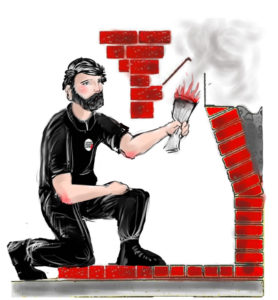Unless you are a Boy Scout or a Survivalist, building a fire is not necessarily second-nature. But with just a few tips, you will have no problem starting a fire in your fireplace.
Steps to Starting a Fire in Your Fireplace
- Open your damper. If necessary, shine a flashlight up inside your fireplace to make sure the damper is fully open.
- Clear the area around the fireplace opening. Remove any combustible material including firewood and newspaper away from the hearth of the fireplace.
- The fire grate should be moved as far back in the fireplace as possible. This will minimize the possibility of a smoking problem.
- Place tinder under the grate. Tinder can be anything from crumpled newspaper (but not the color advertising slicks), dried tree bark, dried leaves, sticks or twigs, pine needles and even dryer lint. Don’t pack the tinder too tight under the grate. The tinder needs to be loose enough for air circulation under the fire.
- Kindling should be placed on top of the grate. Kindling consists of large twigs, and sticks and small splits of wood from 1/4″ to 1″ in diameter. Leave enough space between the kindling to allow for air circulation.
- Arrange small splits of wood on top of the kindling. Use only well-seasoned wood that is split and dry, aged for at least six months. It’s best to start a fire with soft woods and once the fire is established, throw on the hard wood to give a longer lasting fire.
- Prime the flue before starting the fire. Don’t skip this step! It only takes a minute to do but if you don’t do it, you may experience a
 smoking problem at the beginning of the fire. Simply warm up the flue by lighting one end of a rolled up newspaper and hold it in the damper area for about a minute to help establish a good draw in the chimney.
smoking problem at the beginning of the fire. Simply warm up the flue by lighting one end of a rolled up newspaper and hold it in the damper area for about a minute to help establish a good draw in the chimney. - Light the tinder under the grate and close the fire screen. If you have glass doors, keep the doors in a fully open position during an active fire. The glass may implode or explode from the heat or pressure if you close the glass doors.
Sit back and enjoy the beauty and coziness of a fire in your fireplace!
If you prefer, you can use fire starters and fat wood instead of tinder and kindling. These can be purchased in any grocery store next to the prefabricated logs like Duraflame.
During and After the Fire
As the fire burns, the ash will naturally fall under the grate. A healthy bed of ashes under the grate is good and will help keep the fire going and will create more heat from your fire. If the ash starts getting too close to the bottom of the grate, simply spread the ashes out a bit with your poker since there should be good air circulation under the great to keep the fire going.
When adding wood to the fire, never throw the wood on the grate. The sudden force of the wood on the grate can damage the floor of the firebox. Also, embers and sparks can fly onto you or into the room.
Try to time your fire so that it dies off before going to bed. It’s never a good idea to leave an active fire unattended. If you have glass doors, close them before going to bed.
The next morning, if the fire is completely out, close the damper so you don’t have heat loss from the home.
Occasionally you may experience an odor problem the next day that smells like a campfire in your living room. This can be caused if you don’t have glass doors in front of your fireplace and your furnace may have turned on during the middle of the night. In that case, your fireplace lost its draw and then the furnace sucked the smoky air down the chimney and into the room. If this is a common occurrence, the solution would be to install glass doors for your fireplace and/or make sure the furnace doesn’t turn on in the middle of the night.
Odor problems may also be a sign of smoking problems. Check out our web page on smoking problems.
Always make sure to have your chimney inspected and swept by a CSIA Certified Chimney Sweep before using your fireplace!
